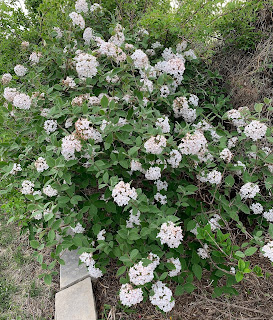
Oh, it's been an eventful weekend here on ProfessorRoush's home place. Work, work, work, sunup to sundown, soreness to sunburn. I'm catching up rapidly on the chores, trying to do the massive and minor garden chores alike before it gets too warm to enjoy.

But first, I must announce a tie this year for "First Rose to Bloom". 'Marie Bugnet' (at left) is struggling in my garden, down to a single stem that I'm going to try to layer and root before it goes, but she still managed to sneak in her perennial virginal white claim to "first bloom." She was given a run for her money, however, by 'Fru Dagmar Hastrup' (above), who managed not one, but
two of these delicate pink blooms to greet the sun on the same day. The final decision was left to the judge, however, like this year's Kentucky Derby, and I've awarded First Bloom to Marie B. again, handicapped as she is by the meager foliage beneath her.

In the meantime, I've got a massive list of accomplishments this weekend. 1) I finished all the bark mulching and weeding of the beds around the house, which involved a total of around 45 bags of mulch in this round. 2) I purchased and planted 13 daylily starts sold yesterday morning at the Farmer's Market by the Flint Hills Daylily Society. 3) I painted our eyesore of a mailbox, much to Mrs. ProfessorRoush's chagrin, since she will have to find something else to express displeasure over. 4) I painted the pasture gate, which was starting to show rust through the previous 20-year-old paint. 5) I opened up 20 or so bales of straw and mulched several lower beds. 6) I planted the gladiola corms you see at the right; a row of multi-color and a row of bright reds to serve as cut flowers later in the season. 7) I weeded the strawberries, onions, peas, and potatoes. 8) I repotted the indoor Christmas Cacti and Easter Lilies. 9) I pruned back several crape myrtles. 10) I mowed the front and back yards. 11) I planted several small shrubs into empty spots. 12) I put Gerbena Daisies into the pots near the garage. 13) I planted two
Miscanthus sinensis ‘Purpurescens’ into two large landscape pots. 14) I filled the bird feeders. 15) I tidied up the garage. 16) I made two trips to box stores to purchase various and sundry needed gardening items including mulch and potting soil. 17) I repaired the vents on the septic bed. 18) I did approximately a seemingly infinite number of "Honey-do" chores for Mrs. ProfessorRoush. 19) Whew...I've forgotten what else. What a weekend!

In other news, I'm very pleased this year with the look of the front landscaping. Even without blooms at present, there's a fair bit of foliage color visible as you can see at the left, looking from the west to the east across the front. Ninebark 'Amber Jubilee', Japanese Maple 'Emperor 1', Forsythia 'Golden Tines', Lilac 'Scent and Sensibility', variegated euonymuses (euonymi?) 'Moonshadow' and 'Emerald Gaiety' and many others give some pleasant texture to all the green around them.
 |
| 'Scent and Sensibility' dwarf lilac |
Speaking of Lilac 'Scent and Sensibility', I'm very happy with this well-behaved addition to the front garden. Standing at 4 years old and a mature height of 2.5 feet and width of 3.5 feet, 'Scent and Sensibility' is marketed as a "dwarf" lilac and is just coming into major bloom as the Syringa vulgaris types fade out, the former's sweet scent permeating the entire front garden at just the right moment. I'm very pleased that this 2015 addition to my garden is making her own mark in the landscape.

Last, but not least, in other blooms, my
Paeonia suffruticosa Tree Peony continues to survive, a miracle here on the prairie. Yesterday it had this single yellow bloom and in today's sunshine, it opened up two more. I mulched around it carefully this weekend,
cognizant that last year a garter snake surprised me by peering out of its leaves, just as I was taking a closeup photo of a bloom. I'm pretty sure the same snake is back, as a couple of branches rustled around when I came close this time as well. Such a nice peony and I can't enjoy it up close again. Drat.

 'Orpheline de Julliet', whom I'll nickname "Orphie" here, is a Gallica rose of unknown heritage. Some sources trace her to William Paul's The Rose Garden published in 1848, while others claim she was listed in Vibert's catalog in 1836 and give her a pre-1836 birthdate. According to Brent Dickinson, the name translates to "July (female) Orphan," so named because she often blooms later than most once-blooming roses, an orphan at the end of the rose season. Here, in Kansas, I wouldn't call her particularly late, as she is blooming along with 'Madame Hardy' and right at the tail of the main rose bloom in my garden. Officially, helpmefindrose.com lists her as "crimson and red", with a strong fragrance, full quartered bloom form, once-blooming, and with a Zone 4 cold tolerance.
'Orpheline de Julliet', whom I'll nickname "Orphie" here, is a Gallica rose of unknown heritage. Some sources trace her to William Paul's The Rose Garden published in 1848, while others claim she was listed in Vibert's catalog in 1836 and give her a pre-1836 birthdate. According to Brent Dickinson, the name translates to "July (female) Orphan," so named because she often blooms later than most once-blooming roses, an orphan at the end of the rose season. Here, in Kansas, I wouldn't call her particularly late, as she is blooming along with 'Madame Hardy' and right at the tail of the main rose bloom in my garden. Officially, helpmefindrose.com lists her as "crimson and red", with a strong fragrance, full quartered bloom form, once-blooming, and with a Zone 4 cold tolerance.

















